
Lot 220

'LADY OGILVY'S DRESS'
A BROCADED ROBE A LA FRANCAISE OR SACK BACK DRESS, CIRCA 1745-50
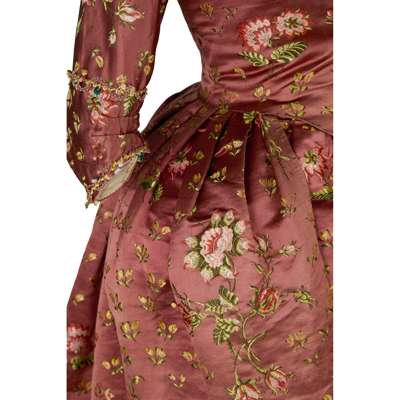
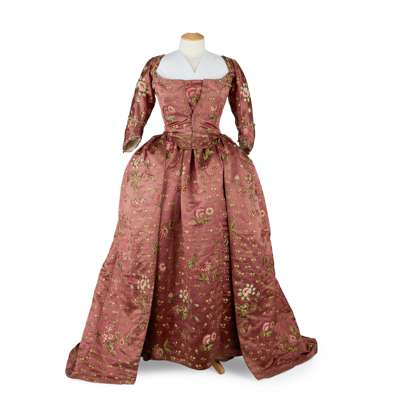
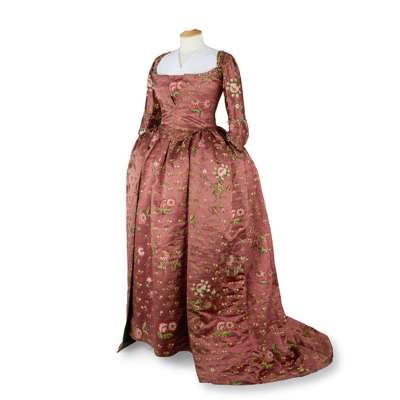
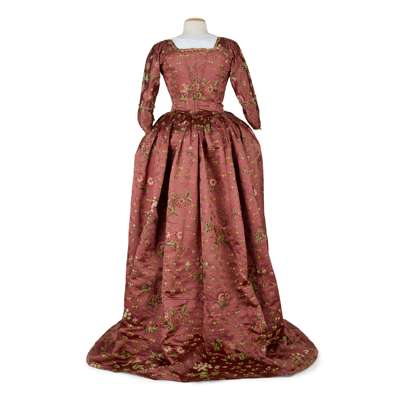

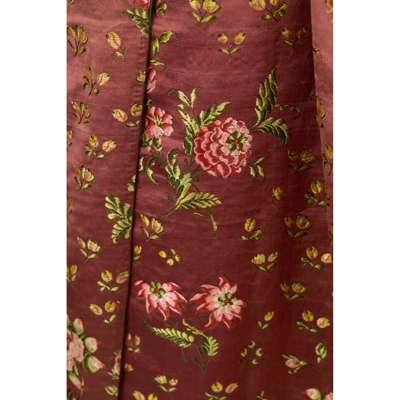
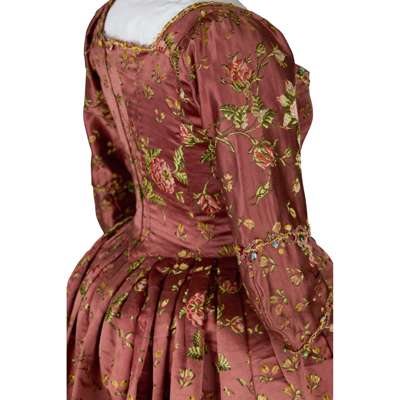
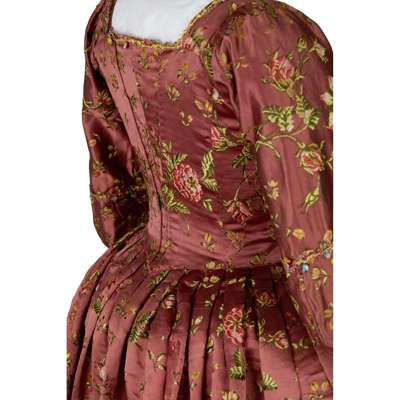
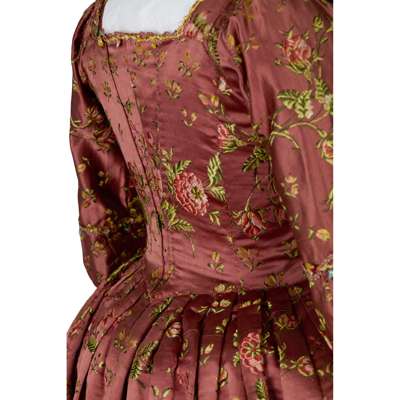
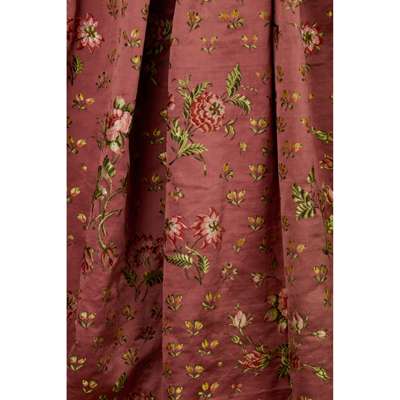
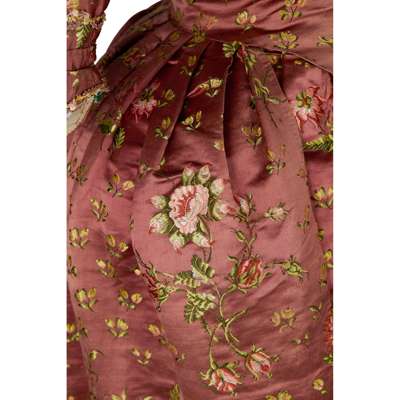


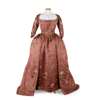
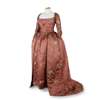
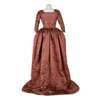

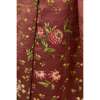
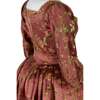
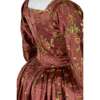
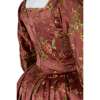
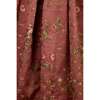
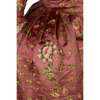
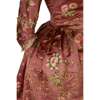
Auction: Day 1: Wednesday 20 August - Lots 1 - 296
Description
altered circa 1780 to a robe à la polonaise style, of dark plum (purple/brown) coloured silk with small brocade flower sprigs all over interspersed with larger floral sprays, high square neckline at the back and an open front, with attached panel without stomacher, three quarter length sleeves and full long skirt, the inside part lined on the front edges and the hem of skirt in green silk and linen, some further later alterations
Dimensions
Approximately 145cm high
Provenance
By repute worn by Lady Margaret Ogilvy, 6th Countess of Airlie, when she was presented at court at the Palace of Holyroodhouse in 1745
Thence by descent through the Ogilvy family, The Earls of Airlie
On long term loan to the Royal Collection, Palace of Holyrood, for almost a hundred years
Exhibited at Bonnie Prince Charlie and the Jacobites, National Museums Scotland, June 23rd to November 12th 2017
Exhibited at Women of Glamis, Glamis Castle, late 2020 - early 2021
Most recently displayed in The Queen's Lobby, next to the Great Gallery, Holyrood Palace, where removed for sale, Summer 2025
Property from the Earls of Airlie
Footnote
This gown is reputed to have been worn by Lady Margaret Ogilvy (1725–1757) upon her presentation at court at the Palace of Holyroodhouse in 1745. Lady Ogilvy and her husband, David Ogilvy (1725–1803), de jure 6th Earl of Airlie, were prominent supporters of the Jacobite cause during the 1745 Rising. Following the Jacobite defeat at Culloden in April 1746, Lady Ogilvy—who was reportedly present as a spectator at the battle—was captured by government forces under the command of the Duke of Cumberland. Alongside other Jacobite sympathisers, she was imprisoned in Edinburgh Castle and condemned to death for treason.
In a daring and now legendary escape in November 1746, Lady Ogilvy is said to have disguised herself in the clothing of a washerwoman to evade her guards. Travelling under the guise of a young gentleman, she reached London, where soldiers allegedly mistook her for Prince Charles Edward Stuart. Her companion managed to convince them that she was instead a noblewoman concealing her identity due to debts of honour. After a medical examination by a woman confirmed her sex, she was released and ultimately fled to France to join her husband in exile.
On 23 September 1745, following the Jacobite victory at the Battle of Prestonpans, Prince Charles Edward Stuart hosted a celebratory ball at the Palace of Holyroodhouse in the Great Gallery. While long thought to be a literary embellishment introduced by Sir Walter Scott in Waverley, recent scholarship has confirmed the historical authenticity of the event. A letter from the Duke of Perth to Lord Ogilvy, dated 30 September 1745 and written at Holyroodhouse, makes explicit reference to a “great ball at ye palace” held on “Monday last.” This document was uncovered by Deborah Clarke, Senior Curator at the Palace of Holyroodhouse, during research for her 2024 publication The Palace of Holyroodhouse.
A gown of similar date and style was formerly in the possession of the Threipland family of Fingask Castle, also known for their Jacobite allegiance. Sold by Christie’s at their sale Fingask Castle in April 1993 (lot 535), this ensemble comprised a “sack-backed open robe and petticoat, of pink silk brocaded with sprays of orange and pink flowers and trimmed with a flybraid, circa 1755-60, the bodice slightly altered, By repute worn by Miss Treipland (sic) at a Ball given by Bonnie Prince Charlie in 1745”. The Threipland collection, housed at Fingask Castle near Perth, contained numerous artefacts relating to the Jacobite cause, further enhancing the contextual reliability of the provenance.
A comparative analysis of the Threipland and Ogilvy gowns highlights shared stylistic features, notably in cut, textile, and decorative trim, consistent with mid-18th-century court fashion. These similarities suggest a shared cultural milieu among elite female supporters of the Stuart court. Although absolute certainty is elusive, the strong stylistic and circumstantial parallels between these garments lend credence to the possibility that Lady Margaret Ogilvy’s gown may have been worn at the 1745 Holyroodhouse ball. If so, it would constitute one of the rare surviving garments directly associated with the ephemeral Stuart court in Edinburgh, and a rare material testament to the women who actively supported the Jacobite cause.























